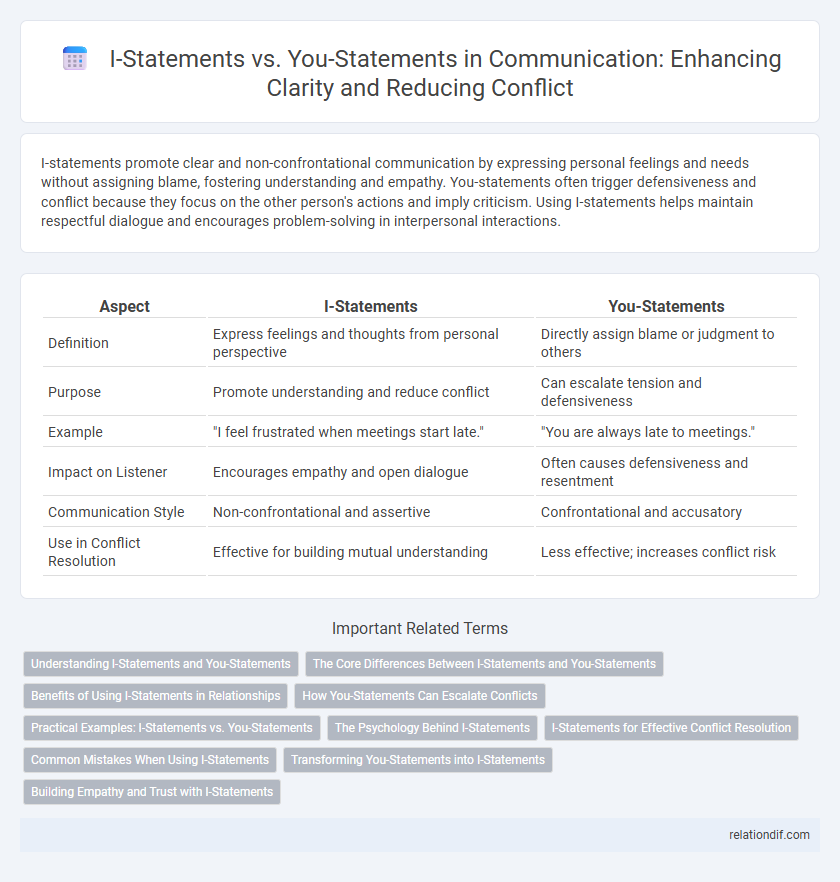I-statements promote clear and non-confrontational communication by expressing personal feelings and needs without assigning blame, fostering understanding and empathy. You-statements often trigger defensiveness and conflict because they focus on the other person's actions and imply criticism. Using I-statements helps maintain respectful dialogue and encourages problem-solving in interpersonal interactions.
Table of Comparison
| Aspect | I-Statements | You-Statements |
|---|---|---|
| Definition | Express feelings and thoughts from personal perspective | Directly assign blame or judgment to others |
| Purpose | Promote understanding and reduce conflict | Can escalate tension and defensiveness |
| Example | "I feel frustrated when meetings start late." | "You are always late to meetings." |
| Impact on Listener | Encourages empathy and open dialogue | Often causes defensiveness and resentment |
| Communication Style | Non-confrontational and assertive | Confrontational and accusatory |
| Use in Conflict Resolution | Effective for building mutual understanding | Less effective; increases conflict risk |
Understanding I-Statements and You-Statements
I-statements express the speaker's feelings and perspectives, fostering personal accountability and reducing defensiveness in conversations. You-statements often assign blame or judgment to the listener, which can trigger conflict and hinder effective communication. Mastering the use of I-statements enhances clarity and promotes empathy during interpersonal exchanges.
The Core Differences Between I-Statements and You-Statements
I-statements focus on expressing the speaker's feelings and experiences, using first-person language that promotes personal responsibility and reduces defensiveness. You-statements attribute blame or judgment to the listener, often triggering negative reactions and conflict. The core difference lies in the perspective: I-statements foster open dialogue by centering on the communicator's emotions, while you-statements can escalate misunderstandings by pointing fingers.
Benefits of Using I-Statements in Relationships
I-statements promote clear and non-confrontational communication by focusing on the speaker's feelings and experiences, which reduces defensiveness and conflict in relationships. These statements facilitate emotional honesty and encourage empathy, fostering deeper understanding and stronger connections between partners. By emphasizing personal responsibility, I-statements help to create a safe space for open dialogue and mutual respect.
How You-Statements Can Escalate Conflicts
You-statements often provoke defensiveness by assigning blame directly to the listener, which escalates conflicts and hinders constructive dialogue. These statements trigger emotional reactions that close off open communication and increase misunderstanding. Shifting to I-statements reduces hostility by expressing personal feelings and needs without accusing, promoting empathy and resolution.
Practical Examples: I-Statements vs. You-Statements
I-statements express personal feelings and experiences, such as "I feel frustrated when meetings start late," promoting ownership and reducing defensiveness. You-statements, like "You never start meetings on time," often provoke blame and resistance, hindering effective communication. Using I-statements enhances conflict resolution and fosters empathy in conversations.
The Psychology Behind I-Statements
I-statements foster personal responsibility by focusing on the speaker's feelings and experiences, reducing defensiveness in conversations. Psychological research highlights that using I-statements activates empathy and promotes emotional regulation, which facilitates more constructive dialogue. This approach contrasts with you-statements, which often trigger accusations and conflict by attributing blame.
I-Statements for Effective Conflict Resolution
I-statements promote effective conflict resolution by focusing on the speaker's feelings and experiences without assigning blame, which reduces defensiveness and encourages open dialogue. By expressing emotions and needs clearly, I-statements foster empathy and understanding between parties. This communication technique enhances accountability and helps de-escalate tensions during disagreements.
Common Mistakes When Using I-Statements
Common mistakes when using I-statements include making them sound accusatory or insincere, which can provoke defensiveness rather than open dialogue. Another frequent error is mixing I-statements with blame, such as saying "I feel you ignore me," which shifts responsibility away from the speaker and undermines the message's effectiveness. Ensuring clarity and genuine self-expression enhances communication by fostering understanding and emotional connection.
Transforming You-Statements into I-Statements
Transforming you-statements into I-statements shifts the focus from blame to personal feelings, promoting constructive dialogue and reducing defensiveness. For example, replacing "You never listen to me" with "I feel unheard when I'm interrupted" encourages empathy and clearer communication. This technique enhances conflict resolution by fostering mutual understanding and emotional ownership.
Building Empathy and Trust with I-Statements
I-statements enhance communication by expressing personal feelings and experiences without assigning blame, fostering empathy and trust in conversations. Using phrases like "I feel" or "I think" invites openness and reduces defensiveness, promoting a safer environment for dialogue. This approach strengthens interpersonal relationships by prioritizing understanding and emotional connection.
I-statements vs you-statements Infographic

 relationdif.com
relationdif.com